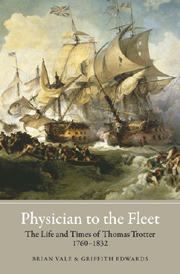Book contents
- Frontmatter
- Contents
- List of Illustrations
- List of Abbreviations
- Foreword
- Preface
- Background
- From Surgeon's Mate to Physician to the Fleet
- The Newcastle Years
- 12 Married Life and Civilian Practice
- 13 An Essay on Drunkenness
- 14 A War of Pamphlets
- 15 A View of the Nervous Temperament
- 16 Physician as Poet and Playwright
- 17 Thomas Trotter and the Great Theatre of Life
- Bibliography
- Index
12 - Married Life and Civilian Practice
from The Newcastle Years
Published online by Cambridge University Press: 12 September 2012
- Frontmatter
- Contents
- List of Illustrations
- List of Abbreviations
- Foreword
- Preface
- Background
- From Surgeon's Mate to Physician to the Fleet
- The Newcastle Years
- 12 Married Life and Civilian Practice
- 13 An Essay on Drunkenness
- 14 A War of Pamphlets
- 15 A View of the Nervous Temperament
- 16 Physician as Poet and Playwright
- 17 Thomas Trotter and the Great Theatre of Life
- Bibliography
- Index
Summary
City and society
NEWCASTLE was an ancient town built on the steep sides of the north bank of the River Tyne, 10 miles from its mouth. Originally a border stronghold, at the beginning of the nineteenth century the city was a seat of local government, a market town and a major port, its waterfront crowded with warehouses and quays and its river filled with ships, coasters, fishing smacks and distinctive local craft called ‘keels’. When Trotter and his new wife arrived to take up residence, Newcastle was still essentially a mediaeval city, though in Georgian times it had begun to spread beyond the limits of its original walls. It still had a castle, but only two of the city gates remained, Newgate to the north-west and Westgate further to the south. The commerce of the town was dominated by the carrying trade, the most important component of which was coal. The district was famous for its mining. The north-east's coalfields were vastly productive and in 1800 accounted for about a third of total national output. Newcastle alone exported 2.5 million tons a year. In times of war, the navy would provide escort for the coal flotillas. The coal industry was a major employer of labour, comprising men, women and small children, and enjoyed the natural advantage of ready access to a river and to the sea. The countryside was cut with wooden wagon-ways along which horses hauled trucks filled with coal to the Tyne, where it was put onto keels and shipped downstream to North and South Shields, to be loaded onto colliers for export.
- Type
- Chapter
- Information
- Physician to the FleetThe Life and Times of Thomas Trotter, 1760–1832, pp. 145 - 155Publisher: Boydell & BrewerPrint publication year: 2011



